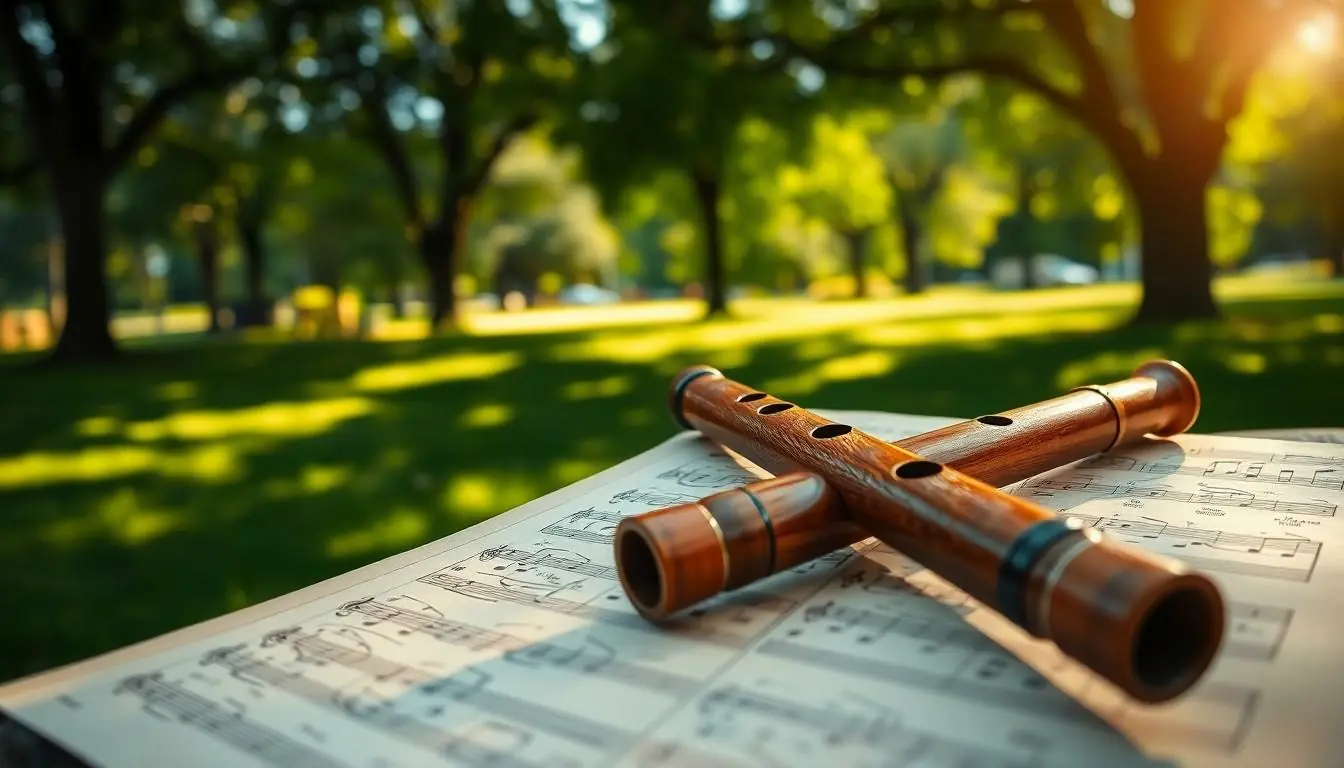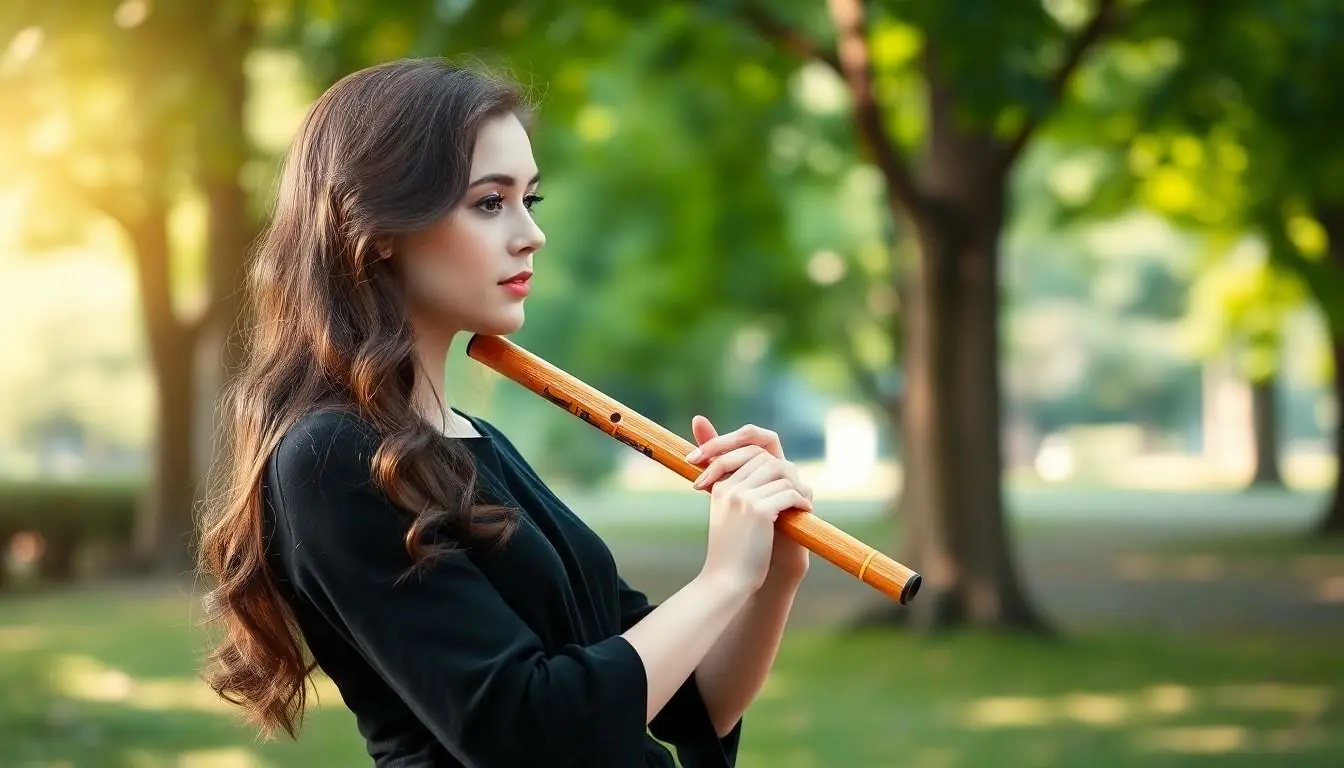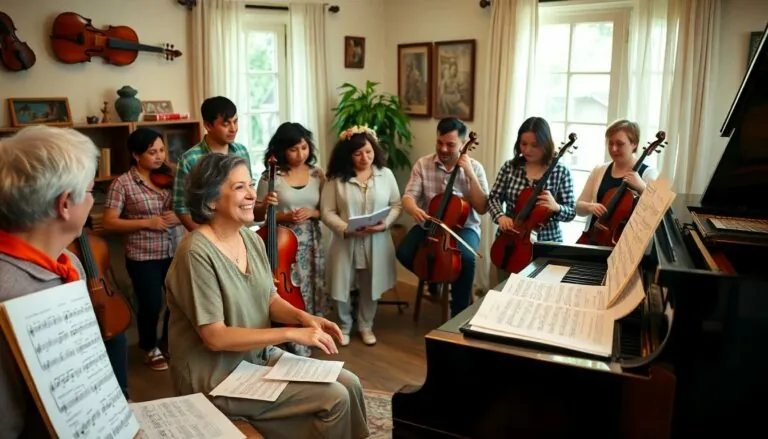Table of Contents
ToggleImagine a world where the sweet, airy notes of a flute whisk you away on a magical journey. Classical flute music isn’t just for stuffy concert halls; it’s an enchanting experience that can turn even the most mundane moments into something extraordinary. From the delicate trills of Mozart to the soaring melodies of Bach, this instrument has a way of captivating hearts and minds alike.
Whether you’re a seasoned aficionado or a curious newbie, the allure of classical flute music beckons you to explore its rich history and stunning versatility. It’s like a fine wine—complex, layered, and best enjoyed with a side of passion. So grab your headphones and get ready to dive into a world where every note tells a story, and every performance is a celebration of artistry. Who knew classical music could be this much fun?
Overview of Classical Flute Music
Classical flute music showcases the instrument’s unique ability to express a wide range of emotions. Originating in the Baroque era, the flute became prominent through compositions by esteemed composers such as Johann Sebastian Bach and Wolfgang Amadeus Mozart. Bach’s “Brandenburg Concerto No. 5” features intricate flute passages that highlight technical skill and artistry.
Mozart’s works, including “Concerto for Flute and Orchestra in G Major,” demonstrate the flute’s lyrical qualities, captivating audiences with its sweet tone. Composers like Camille Saint-Saëns and François Borne further explored the flute’s versatility, contributing significant pieces that expanded its repertoire.
Performances often include baroque, classical, and contemporary styles, allowing a rich tapestry of sound. Musicians employ various techniques, such as vibrato and flutter tonguing, to enhance expressiveness. Audiences resonate deeply with the flute’s ability to evoke feelings, from joy to melancholy.
Notable flute concertos stand as key works within the classical music canon, attracting both performers and listeners. Flute sonatas, often accompanied by piano, create intimate settings that draw audiences in. Ensembles featuring flutes, like orchestras and chamber groups, foster collaborative music-making that enriches the listening experience.
In modern contexts, classical flute music continues to thrive, inspiring new generations of musicians. Educational institutions include flute studies, nurturing talent and creativity. Festivals dedicated to flute music showcase emerging artists, celebrating the instrument’s legacy and relevance today.
Historical Context

Classical flute music has a rich history, tracing back to ancient civilizations. The instrument’s evolution reflects cultural changes and musical innovation over centuries.
Origins of the Flute
In ancient times, flutes appeared in various forms across cultures. Archaeological findings show wooden and bone flutes dating back over 35,000 years. The earliest flutes, often crafted from natural materials, played simple melodies. Different societies embraced the flute, adapting its design to their musical traditions. Their impact on early music lays the foundation for the modern flute and its repertoire.
Evolution Through the Ages
The flute’s development witnessed significant advancements throughout musical eras. During the Renaissance, makers refined the instrument’s structure, producing softer yet richer sounds. The Baroque period introduced key features such as keys and a broader range, enhancing expressiveness. Composers integrated the flute into orchestras, showcasing its versatility in concertos and chamber works. By the Classical and Romantic periods, innovations further enriched flute construction. The modern flute evolved into a sophisticated instrument, allowing musicians to explore diverse styles and techniques seamlessly.
Key Composers and Works
Classical flute music features numerous influential composers and their celebrated works, showcasing the instrument’s charm and versatility.
Famous Flute Concertos
Mozart’s “Concerto for Flute and Orchestra in G Major” stands as a cornerstone of flute repertoire. Composed in 1778, this concerto highlights the flute’s lyrical qualities and technical agility. Another significant work is Carl Philipp Emanuel Bach’s “Flute Concerto in D Minor,” which reflects the transition from Baroque to Classical styles. This piece emphasizes emotional expression through dynamic contrasts and intricate melodies. Jacques Ibert’s “Concerto for Flute and Orchestra” is essential as well, demonstrating modern techniques and playful rhythms. Each concerto contributes to the flute’s rich history, captivating audiences through its expressive capabilities.
Notable Chamber Music Pieces
Claude Debussy’s “Sonatine for Flute and Piano” showcases the blending of impressionistic sounds with classical traditions. This piece evokes vivid imagery through its colorful harmonies and intricate textures. Another fine example comes from Francis Poulenc, whose “Flute Sonata” features charming melodies and rhythmic vitality. This sonata highlights the flute’s agility while maintaining lyrical beauty. Bohuslav Martinů’s “Sonatina for Flute and Piano” deserves mention as well. This composition combines folk influences with innovative structures, creating a captivating dialogue between instruments. These chamber works enrich the flute’s repertoire, emphasizing its collaborative nature and expressive depth.
Performance Techniques
Performance techniques in classical flute music are essential for conveying emotion and technical proficiency. Mastery of these techniques enhances the flute’s expressive possibilities.
Breath Control and Articulation
Breath control plays a crucial role in flute performance, allowing for sustained notes and dynamic phrasing. Proper diaphragm engagement creates a steady airflow, crucial for achieving a rich tone. Articulation serves as the other key component, enabling notes to pop with clarity. Tonguing techniques, such as single, double, and legato tonguing, influence the articulation style. Practicing scales and exercises aids in developing fluidity and precision in articulation. In combination, breath control and articulation elevate the overall sound quality and musical impact.
Interpretation and Expression
Interpretation shapes the emotional delivery of a performance. Understanding the context of each piece influences interpretative choices. Musicians analyze the phrasing and dynamics, allowing for personalized expressions. This involves variations in tempo and volume to bring out individual feelings. Emotional connection to the music inspires expressive performance, captivating the audience. Additionally, phrasing techniques enhance storytelling through musical lines. These aspects contribute to a unique interpretative style that distinguishes one musician from another.
Contemporary Influence
Contemporary classical flute music exhibits a dynamic connection to modern compositions and the current music landscape.
Modern Compositions for Flute
New works frequently emerge, showcasing innovative techniques and expanded musical languages. Composers such as Kaija Saariaho and Andrea Cavalli push boundaries with their avant-garde approaches. Notable examples include Saariaho’s “Cendres,” which explores sound textures, and Cavalli’s “Flute Sonatina,” emphasizing rhythmic complexity. Each composition invites flutists to explore fresh interpretations and techniques, enriching the instrument’s repertoire and appeal.
Flute in Today’s Music Scene
The flute remains a versatile presence in various genres, particularly in crossover collaborations. Artists like Imani Winds and flutist Claire Chase blend classical elements with jazz, pop, and world music influences. Festivals and competitions dedicated to the flute foster creativity and engagement among musicians. These opportunities enhance the instrument’s visibility, encouraging diverse audiences to appreciate the flute’s expressive capabilities. Collaborations between flutists and contemporary composers continuously inspire new performances while keeping classical flute music relevant today.
Classical flute music stands as a testament to the instrument’s timeless charm and emotional depth. Its journey from ancient civilizations to contemporary compositions showcases not only its evolution but also its ability to resonate with audiences across generations. The expressive capabilities of the flute continue to inspire musicians and listeners alike, creating a rich tapestry of sound that bridges the past and present.
With its unique blend of technical skill and lyrical beauty, the flute remains a vital part of the classical music landscape. As new works and innovative collaborations emerge, the legacy of classical flute music thrives, inviting everyone to discover its enchanting allure.






